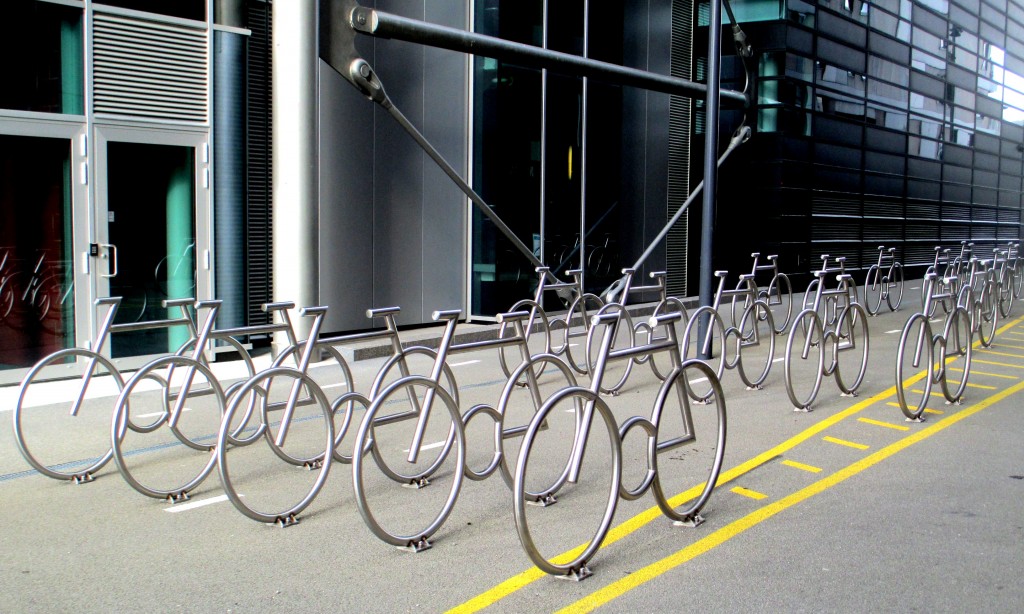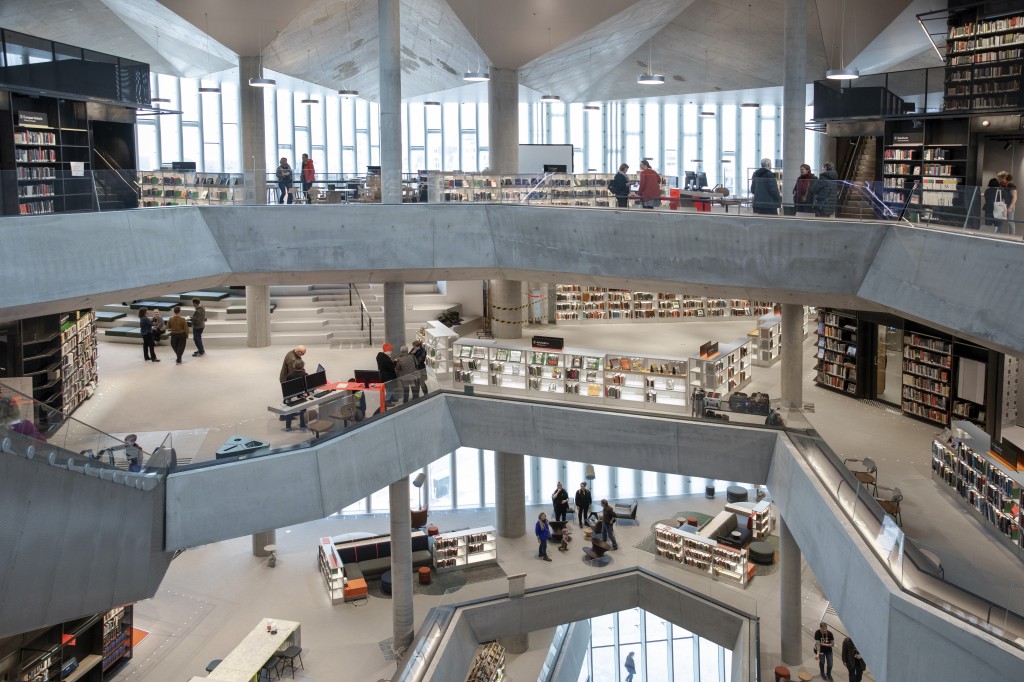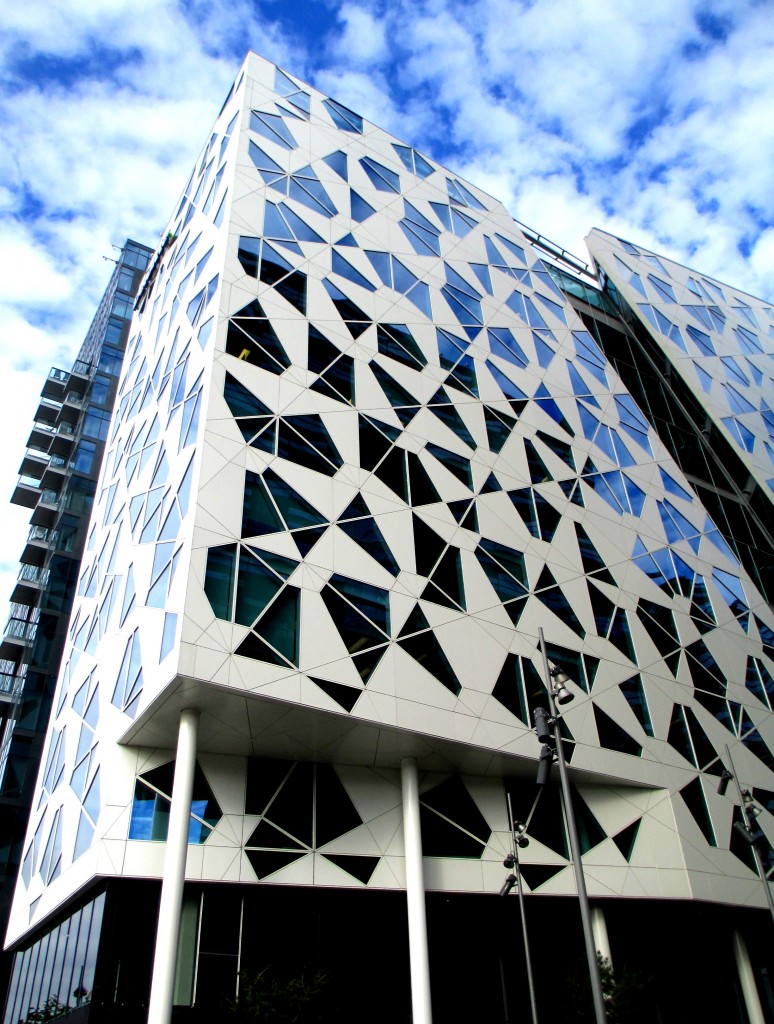
New Deichman Bjorvika Central Library (left) on Oslo Waterfront close to the Oslo Opera House (right) (photo Einar Aslaksen)
By Ron Bernthal
The library of the future has finally opened. Located between Oslo Central Station and the Oslo Opera House, the new Deichman Bjørvika Central Library is now part of the city’s 235 year history of the public library in Norway’s capital city. Designed by the Oslo-based studio Atelier Oslo and Lundhagem Architects, the group won the international competition to design the library in 2009.
Stretching over six floors and about 145,000 square-feet, the building will house over 450,000 books, and offer lots of meeting spaces, learning rooms, and lots of activities for adults and children. Visitors can watch movies, learn to make podcasts, take piano lessons, use 3D printers, enjoy the view of the Oslo Fjord, or just admire the architecture and design of Lundhagem and Atelier Oslo.
In early 2020 about 1,000 Norwegian schoolchildren moved 6,000 books from the 1930′s-era Deichman library to the new Deichman Bjørvika. With colourful rucksacks full of children’s books on their backs, the children filled the streets of central Oslo and brought the library’s new building to life with cheering and dancing. The original plan was to open Deichman Bjørvika to the public on March 28th 2020. However, Covid-19 and the national lockdown in March put a stop to that. After a successful country lockdown eased the Covid-19 crisis, however, Library Director Skansen was able to open the building’s doors to the public on June 18, 2020, just three months from the original date.
“We are looking forward to letting this house fill with people. Opening a building such as this in Oslo is a great event. Finally the people of Oslo and visitors can come to us and start using the library. We are looking forward to show people this building which we are so proud of. I think everyone in Oslo will be proud themselves because this is after all their building”, said Skansen.
Deichman Bjørvika’s ambition is to host two million visitors each year — in a Covid-free situation. Among the safety measures regarding infection control is a temporary limit on the number of visitors who can be present in the library at the same time: 1,000, compared to the usual limit of 3,000. This restriction has been determined after consultations with local infection control authorities.
“The library is a very special place,” said Governing Mayor Raymond Johansen.
“It’s an open door to the world of literature. An open door to a meeting place across history, class, gender, and age. The new Deichman library has been built on one of the best plots in Oslo and that shows that we as a society and as a city prioritize culture. That we prioritize people and that we prioritize meeting places that are open for everyone.”

The artwork BRAINSTORM by Lars Ø Ramberg inside the library. The artwork took over three years to produce. The result is a gigantic piece of conceptual art, comprising over 1,200 feet of handmade glass (photo CF-Wesenberg)
The area around the inlet of Bjørvika east of the city centre has been completely transformed. Around the year 2000 this area was known for a major highway junction and a container port. Today, the highway is gone and the containers have been replaced with design-savvy residential and mixed-used buildings. Bjørvika Barcode is now a vibrant district with fascinating architecture and great outdoor spaces.
Bjørvika Barcode consists of twelve narrow high-rise buildings of different heights and widths. The buildings are built with some space in between them, thus jointly resembling a barcode. The Barcode district buildings house leading national and international businesses, and 10,000 people work here on a daily basis. The buildings also contain 400 residential units and a daycare center. On street level, there are many good restaurants, shops, art galleries and other services.

Art galleries and street art, like these metal bicycles, can be found on the streets of the Barcode district, close to the new library. (photo Ron Bernthal)
The Barcode district architecture concept was developed by the Norwegian firms DARK and a-lab, in collaboration with the Dutch agency MVRDV. The “barcode” concept is designed as a geometric system that stands out architecturally. The concept incorporates values such as openness to the fjord, admittance of light and airiness.
Formerly an old container dock, Sørenga has also been transformed into a brand new neigborhood by the Oslo Fjord. The area consists of residential complexes with unique architectural details. A green park with several channels stretches through the whole area. At the southernmost tip you’ll find the Sørenga Seawater Pool, a popular recreational spot for Oslovians in summertime. Several waterfront restaurants offer great food in maritime surroundings.
Visit Oslo
https://www.visitoslo.com/en




